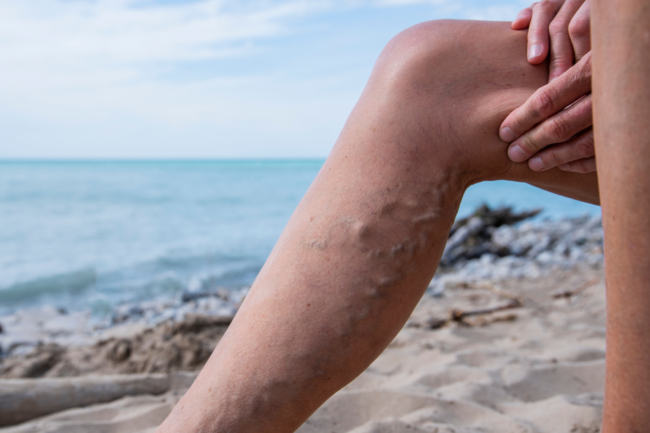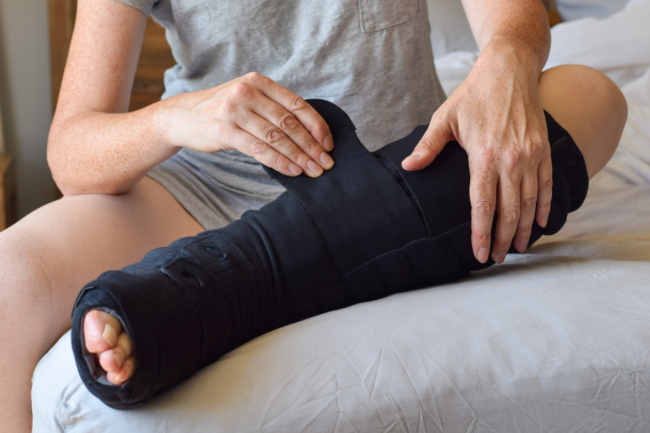Cankles is a condition where the ankle is roughly the same size as the calf: i.e., the leg doesn’t ‘taper’ at the ankle. This swollen look to the ankle can result from many things, from thicker bones to a 10-hour flight to an underlying medical condition. Let’s explore the many causes of cankles and how to address them.
Non-serious causes of cankles
Cankles could be in your genes
Sometimes heredity plays a role in your anatomy. If one of your parents had ‘thick’ ankles, you may have them too. Thicker bones, a larger ankle joint, and how your fat is naturally distributed can all contribute to the bigger appearance.
They may be due to your weight
If you are overweight or obese, your body may store more fat around the ankles, giving them the cankle appearance.
It could just be temporary swelling
Fluid buildup in the ankle tissue can also result in a cankle-like appearance. It can sometimes happen on a long-haul (5+ hour) flight, after a long day of sitting at the office or being on your feet, and even in hot weather.
Pregnancy can lead to cankles
Many women develop cankles during pregnancy because of impacted blood circulation and diminishing physical activity. When you’re pregnant, blood volume doubles to support your growing baby, and the pressure on your abdominal veins increases as the uterus expands. As fluids can’t get out of tissues fast enough, they build up – especially around the legs and feet.
Excess water retention can lead to swollen ankles
If your lower legs are swollen even when you’re not pregnant, then you may be suffering from water retention. Poor nutrition or a high sodium intake might play a part.
Home remedies for cankles
Unfortunately, you can’t remedy genetic cankles. But for other causes, there are ways to improve their appearance at home.
- Wear compression stockings to stimulate the muscles and move excess fluid out of the lower legs
- Elevate the legs to ‘drain’ fluid out
- Apply an ice pack to combat swelling
- Reduce your sodium intake
- Eat more fruits and vegetables to ensure your veins have everything they need to stay strong
- Exercise at least 30 minutes a day and don’t sit or stand too long if you can avoid it. Make an effort to move around every 30 minutes or so. Exercise and eating right will also help manage weight.
- Do some calf tining exercises like calf raises, walking on your toes, and resisted ankle flexion, extension, supination, and pronation (all you need for the latter 4 are a table and a resistance band.)
Could your cankles be a health concern?
Sometimes the formation of cankles can signify an underlying health concern. Conditions that can lead to cankles include:
Injury or infection
The ankles can swell up due to trauma or an immune response. A surgery, sprain, strain, and even an insect bite can cause a cankle-like appearance.
Lymphedema
Lymphedema is tissue swelling due to the accumulation of protein-rich lymphatic fluid in the tissue, typically around the arms or legs. The lymphatic system drains this fluid, but damage to or removal of a lymph node (such as through cancer treatments) can disrupt this process. Lymphedema can be temporary or develop into a chronic condition. Left unaddressed, it can increase your risk of infection, fibrosis (hardening of the skin), and difficulty moving the affected limb.
Blood clot
Deep Vein Thrombosis (DVT) is a blood clot that forms in the deep vein. These clots usually form from long hours of inactivity, vein disorders like varicose veins, injury to the limb, and clotting disorders. If the clot is in a leg vein, it can cause swelling. It can also cause pain, tenderness, and skin that is red and/or warm to the touch.
Kidney disease
The kidneys are responsible for clearing out waste from the body by filtering your blood. When the kidneys can’t remove enough water and salt from your body, pressure can build in the blood vessels. As a result, you may get oedema (swelling) around the legs and eyes.
Lipedema
Fat tissue can sometimes accumulate abnormally. Usually, lipedema affects the hips and buttocks, but it can also appear in other areas, ankles included. Being genetically predisposed to the condition, having a BMI of over 35, and being a woman (or assigned female at birth) increases your risk of developing it. Unlike normal fat, lipedema fat is painful, significantly more noticeable in the area it affects, and can make it difficult to stay active at later stages.
Varicose veins or CVI can cause cankles
Damaged vein walls or valves can lead to chronic venous insufficiency (CVI). When blood can’t flow back up to the heart, it begins to reflux or pool. Vessels then twist and enlarge, becoming varicose veins. As circulation through these veins slows, fluid builds up, sometimes resulting in swelling around the lower legs.
Treatments for cankles caused by medical issues
Injury: PRICE (protection through a brace, rest, ice, compression, and elevation) will reduce inflammation and help the injury heal
Infection: see a doctor. They will likely prescribe antibiotics or other medications
Lymphoedema: You should see your doctor ASAP if you notice abnormal swelling. With your doctor’s guidance, you can manage lymphedema through:
- Exercise
- A healthy diet
- Wearing compression socks or a pneumatic compression device (pictured above)
- Lymphatic drainage massage
While there’s no cure for lymphedema, treating it through a lymph node transplant (i.e., moving a healthy lymph node from one part of your body into the affected limb) or creating a new drainage pathway has shown good results.
DVT: Seek medical attention immediately if you experience these symptoms. While there’s no cure for DVT, the clot can dissolve through thrombolytic medication. Wearing compression, staying well-hydrated, and, in some cases, anticoagulants may be recommended to prevent future occurrences.
Kidney disease: In the early stages, you can keep your kidney disease under control through a kidney-friendly diet, keeping your doctor in the loop, and taking the medications they prescribe. In later stages, you will likely need dialysis or a kidney transplant.
Lipedema: There are some conservative methods and medical treatments that can help manage the pain. These include:
- Lymphatic drainage massage
- An anti-inflammatory diet
- Medications like metformin and selenium
- Wearing compression stockings or a pneumatic compression device
- Liposuction
- Bariatric surgery
CVI and varicose veins: Unfortunately, once a vein valve is damaged, there is no way to fix it. However, you can manage varicose veins through conservative methods like wearing compression socks, exercising, and elevating the legs. You can also treat them through surgical removal or minimally invasive sealing. Treatments like Endovenous Laser Ablation don’t require general anaesthesia or large incisions. Once the problem vein is gone, your circulation should return to normal. And if your cankles resulted from the varicose veins, they will resolve soon after.
Seek expert advice
The doctors at The Vein Institute specialise in treating varicose leg veins. Call us on 0420 102 637, or fill out our booking request form.


